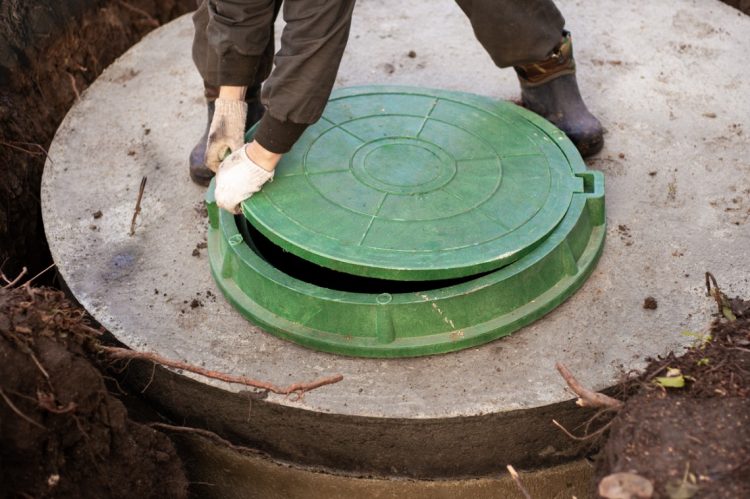Regarding managing wastewater, two primary options are available: a septic system and a public sewer. Both systems handle and treat wastewater but differ in infrastructure, maintenance and costs.
Understanding the differences between a septic system and public sewer is essential for homeowners, as it affects their daily lives, expenses and environmental impact.
We will explore these two systems in detail, covering the cost of septic pumping, replacing a septic system and the key contrasts between a septic system and a public sewer. If you are purchasing a home with a septic system, it should be checked during the home inspection period.
Septic system
A septic system is an on-site wastewater treatment system typically used in rural and suburban areas where a public sewer system is not available or practical. It consists of three main components: a septic tank, a drain field and the soil beneath it. Septic pumping is vital for the life of the system.
Septic tank
The septic tank is an underground concrete, fiberglass or plastic container. It receives all the wastewater from the household, including water from toilets, showers, sinks and laundry. The tank separates solid waste (sludge) from liquid waste (effluent) through sedimentation and microbial digestion. Bacteria present in the tank break down organic matter, reducing its volume.
Drain or leach field
After wastewater is treated in the septic tank, the liquid effluent flows into the drain field. This field consists of perforated pipes buried in gravel trenches or a bed of sand. The effluent is distributed through these pipes, allowing it to percolate into the surrounding soil. The soil acts as a natural filter, removing harmful pathogens and contaminants before the water reaches groundwater sources.
Maintenance and pumping
Regular maintenance is crucial for properly functioning septic systems. The tank must be pumped periodically to remove accumulated sludge and prevent it from clogging the drain field.
The pumping frequency depends on tank size, household size and water usage. On average, septic tanks should be pumped every three to five years. Septic pumping costs vary based on the tank size and the distance to the disposal site.
Replacing a septic system
Septic systems are designed to last for several decades with proper maintenance. However, they may eventually require replacement due to age, damage or increased household size. Replacing a septic system involves excavating the old tank, installing a new one and ensuring compliance with local regulations.
The cost of replacing a septic system can vary significantly based on factors such as the tank’s size, the installation’s complexity, soil conditions and local labor costs.
On average, homeowners can expect to spend between $15,000 and $25,000 for a complete septic system replacement. It is essential to consult with professionals and obtain multiple quotes to get an accurate estimate for your specific situation.
Public sewer
A public or municipal sewer system is a centralized network of underground pipes and treatment facilities managed by local governments. It is typically found in urban and suburban areas where homes and buildings are close.
Connecting to the sewer system
Properties connected to a public sewer system transport wastewater through a series of pipes to a centralized treatment facility. Once there, the wastewater undergoes various treatment processes to remove contaminants and pollutants before being safely discharged into water bodies or reused for irrigation.
Maintenance and costs
Unlike septic systems, homeowners connected to public sewers do not need to worry about regular maintenance or septic pumping costs. The responsibility for maintaining and repairing the sewer lines lies with the local municipality. However, homeowners are generally required to pay sewer usage fees or taxes to cover the public sewer system’s operational costs and infrastructure maintenance.
Pros and cons of septic system versus public sewer:
Costs
A septic system installation is typically higher upfront than connecting to a public sewer system. However, once connected, homeowners on public sewers may face higher monthly sewer bills or taxes. On the other hand, septic system owners have lower ongoing costs but need to budget for periodic maintenance, pumping and potential replacement expenses.
Independence and control
Septic systems offer homeowners more control over their wastewater management, as they are not reliant on the local municipality’s infrastructure. Septic system owners can make decisions regarding maintenance, repairs and upgrades on their terms.
Public sewer users have less direct control, as the municipality manages the system and sets the rules and regulations.
Environmental impact
Both septic systems and public sewers have environmental implications. Well-maintained and properly functioning septic systems can be environmentally friendly, as the soil acts as a natural filter and wastewater is treated on-site. However, if a poorly maintained septic system malfunctions, it can contaminate groundwater and nearby water bodies.
If you have private well water, it should be checked when there is a septic system.
Public sewer systems, when well-managed, have the advantage of centralized treatment facilities that can employ advanced technologies to treat wastewater more efficiently.
Final thoughts
Choosing between a septic system and a public sewer depends on various factors, including location, budget and personal preferences. Septic systems offer independence and lower ongoing costs but require regular maintenance and occasional pumping.
Public sewers provide convenience and centralized treatment but have higher monthly fees and less direct control. Ultimately, homeowners should assess their needs and consult with professionals to make an informed decision regarding their wastewater management system.
Bill Gassett is a nationally recognized real estate leader who has been helping people buy and sell MetroWest Massachusetts real estate for the past 35 years.












